Project on Light Rail Services in Sydney
VerifiedAdded on 2023/01/18
|13
|3225
|56
AI Summary
This project focuses on the analysis of the project schedule, development of the project budget and cost management plan, assessment of the health of the project using earned value analysis, and assessment of contemporary project management practices related to the project.
Contribute Materials
Your contribution can guide someone’s learning journey. Share your
documents today.
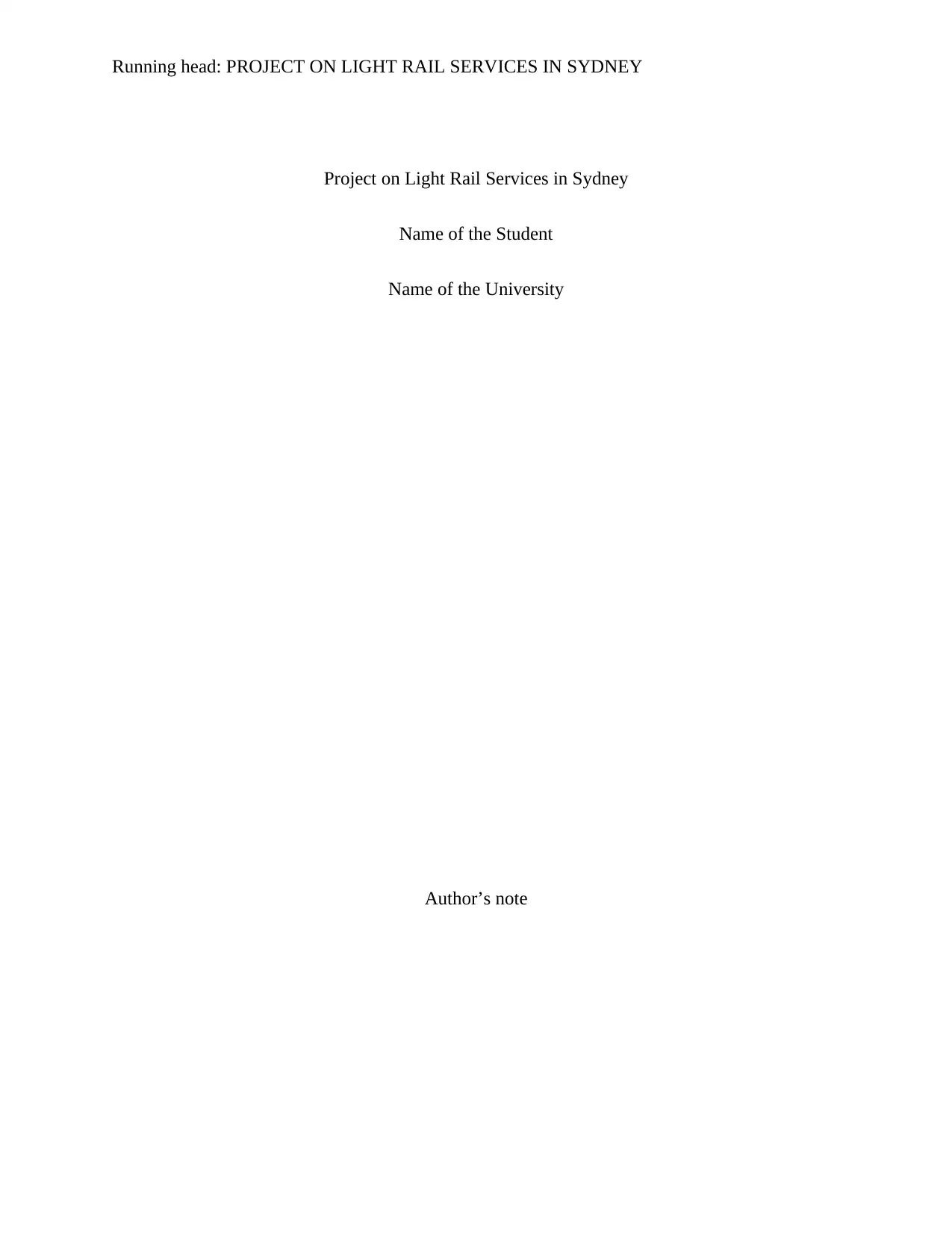
Running head: PROJECT ON LIGHT RAIL SERVICES IN SYDNEY
Project on Light Rail Services in Sydney
Name of the Student
Name of the University
Author’s note
Project on Light Rail Services in Sydney
Name of the Student
Name of the University
Author’s note
Secure Best Marks with AI Grader
Need help grading? Try our AI Grader for instant feedback on your assignments.
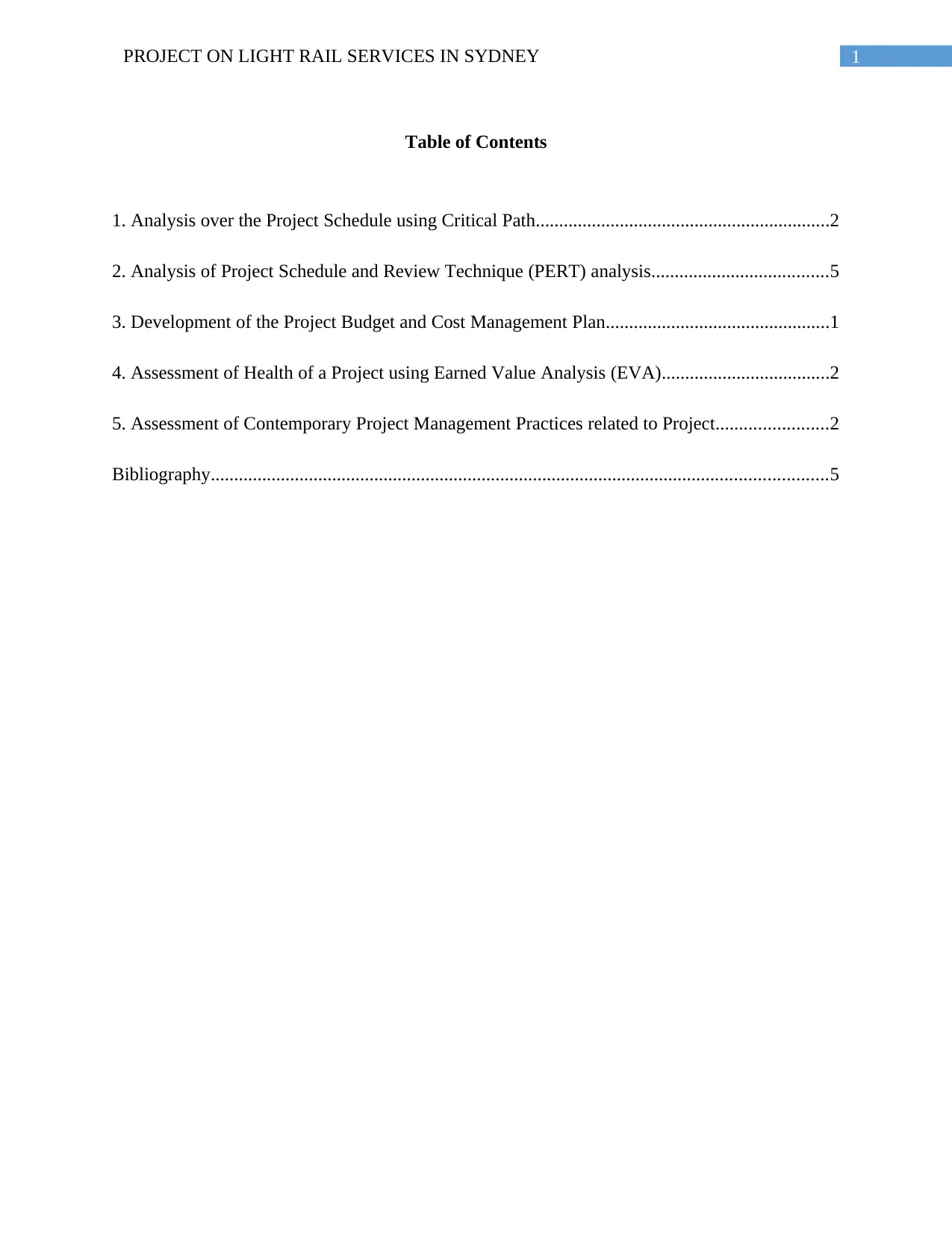
1PROJECT ON LIGHT RAIL SERVICES IN SYDNEY
Table of Contents
1. Analysis over the Project Schedule using Critical Path...............................................................2
2. Analysis of Project Schedule and Review Technique (PERT) analysis......................................5
3. Development of the Project Budget and Cost Management Plan................................................1
4. Assessment of Health of a Project using Earned Value Analysis (EVA)....................................2
5. Assessment of Contemporary Project Management Practices related to Project........................2
Bibliography....................................................................................................................................5
Table of Contents
1. Analysis over the Project Schedule using Critical Path...............................................................2
2. Analysis of Project Schedule and Review Technique (PERT) analysis......................................5
3. Development of the Project Budget and Cost Management Plan................................................1
4. Assessment of Health of a Project using Earned Value Analysis (EVA)....................................2
5. Assessment of Contemporary Project Management Practices related to Project........................2
Bibliography....................................................................................................................................5
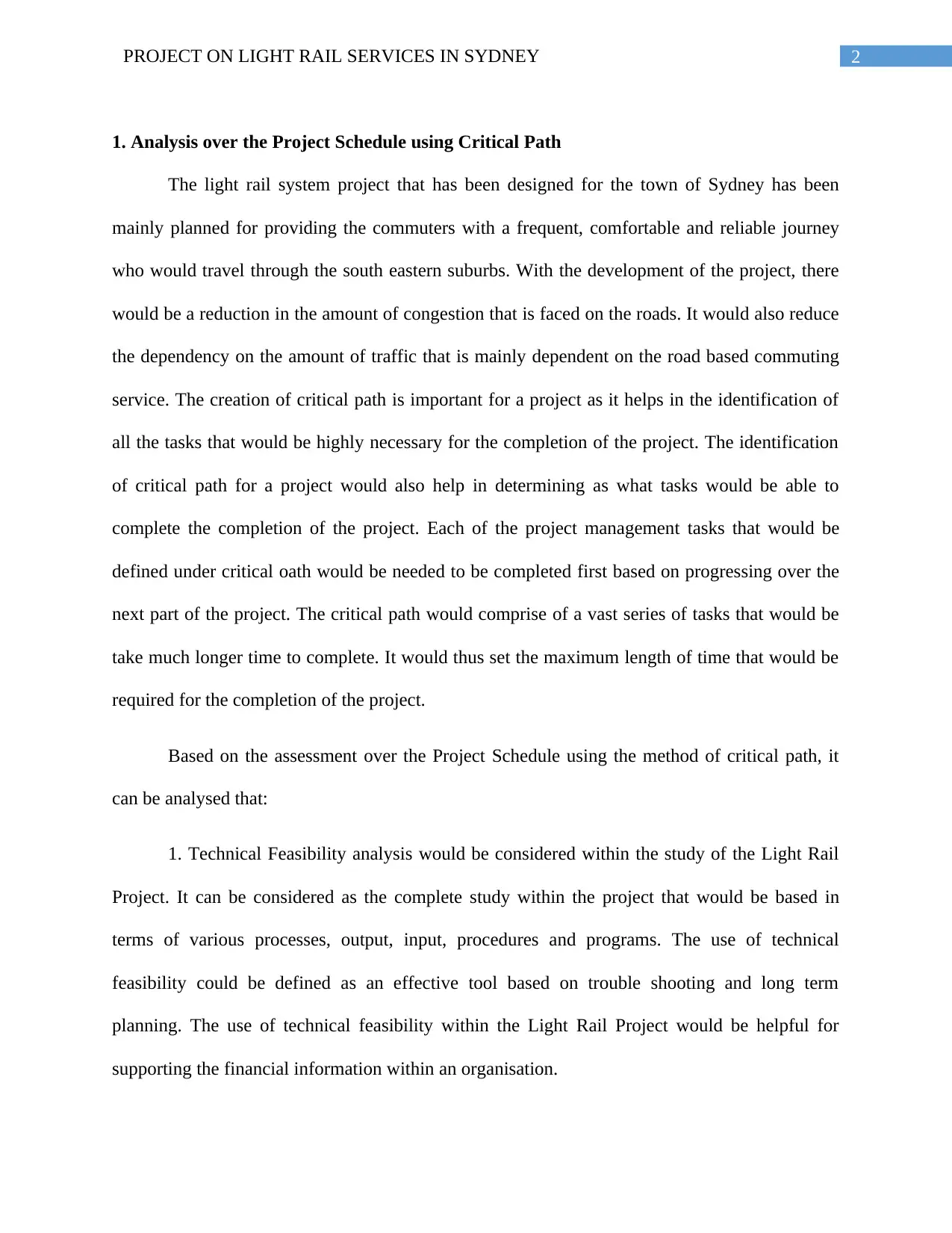
2PROJECT ON LIGHT RAIL SERVICES IN SYDNEY
1. Analysis over the Project Schedule using Critical Path
The light rail system project that has been designed for the town of Sydney has been
mainly planned for providing the commuters with a frequent, comfortable and reliable journey
who would travel through the south eastern suburbs. With the development of the project, there
would be a reduction in the amount of congestion that is faced on the roads. It would also reduce
the dependency on the amount of traffic that is mainly dependent on the road based commuting
service. The creation of critical path is important for a project as it helps in the identification of
all the tasks that would be highly necessary for the completion of the project. The identification
of critical path for a project would also help in determining as what tasks would be able to
complete the completion of the project. Each of the project management tasks that would be
defined under critical oath would be needed to be completed first based on progressing over the
next part of the project. The critical path would comprise of a vast series of tasks that would be
take much longer time to complete. It would thus set the maximum length of time that would be
required for the completion of the project.
Based on the assessment over the Project Schedule using the method of critical path, it
can be analysed that:
1. Technical Feasibility analysis would be considered within the study of the Light Rail
Project. It can be considered as the complete study within the project that would be based in
terms of various processes, output, input, procedures and programs. The use of technical
feasibility could be defined as an effective tool based on trouble shooting and long term
planning. The use of technical feasibility within the Light Rail Project would be helpful for
supporting the financial information within an organisation.
1. Analysis over the Project Schedule using Critical Path
The light rail system project that has been designed for the town of Sydney has been
mainly planned for providing the commuters with a frequent, comfortable and reliable journey
who would travel through the south eastern suburbs. With the development of the project, there
would be a reduction in the amount of congestion that is faced on the roads. It would also reduce
the dependency on the amount of traffic that is mainly dependent on the road based commuting
service. The creation of critical path is important for a project as it helps in the identification of
all the tasks that would be highly necessary for the completion of the project. The identification
of critical path for a project would also help in determining as what tasks would be able to
complete the completion of the project. Each of the project management tasks that would be
defined under critical oath would be needed to be completed first based on progressing over the
next part of the project. The critical path would comprise of a vast series of tasks that would be
take much longer time to complete. It would thus set the maximum length of time that would be
required for the completion of the project.
Based on the assessment over the Project Schedule using the method of critical path, it
can be analysed that:
1. Technical Feasibility analysis would be considered within the study of the Light Rail
Project. It can be considered as the complete study within the project that would be based in
terms of various processes, output, input, procedures and programs. The use of technical
feasibility could be defined as an effective tool based on trouble shooting and long term
planning. The use of technical feasibility within the Light Rail Project would be helpful for
supporting the financial information within an organisation.
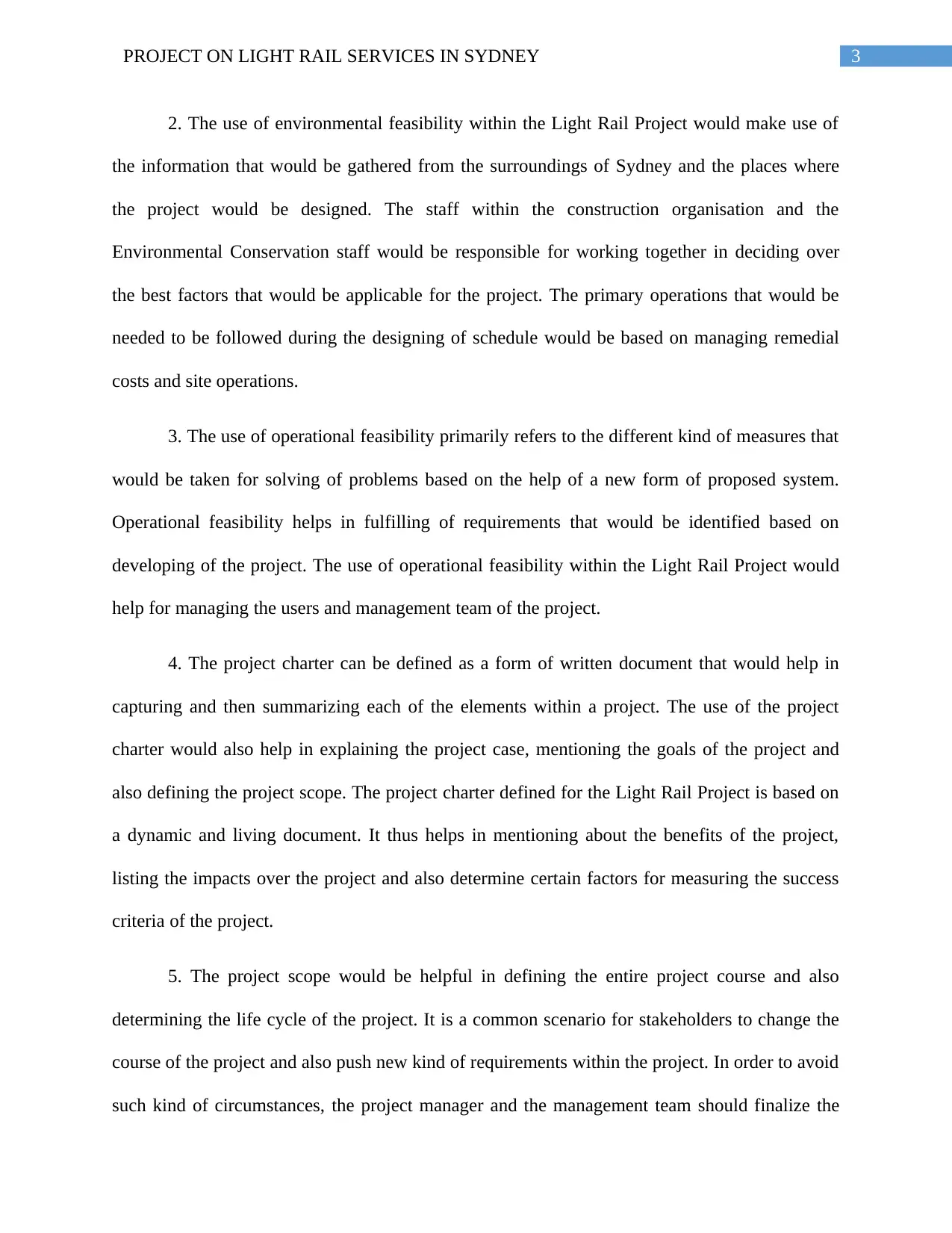
3PROJECT ON LIGHT RAIL SERVICES IN SYDNEY
2. The use of environmental feasibility within the Light Rail Project would make use of
the information that would be gathered from the surroundings of Sydney and the places where
the project would be designed. The staff within the construction organisation and the
Environmental Conservation staff would be responsible for working together in deciding over
the best factors that would be applicable for the project. The primary operations that would be
needed to be followed during the designing of schedule would be based on managing remedial
costs and site operations.
3. The use of operational feasibility primarily refers to the different kind of measures that
would be taken for solving of problems based on the help of a new form of proposed system.
Operational feasibility helps in fulfilling of requirements that would be identified based on
developing of the project. The use of operational feasibility within the Light Rail Project would
help for managing the users and management team of the project.
4. The project charter can be defined as a form of written document that would help in
capturing and then summarizing each of the elements within a project. The use of the project
charter would also help in explaining the project case, mentioning the goals of the project and
also defining the project scope. The project charter defined for the Light Rail Project is based on
a dynamic and living document. It thus helps in mentioning about the benefits of the project,
listing the impacts over the project and also determine certain factors for measuring the success
criteria of the project.
5. The project scope would be helpful in defining the entire project course and also
determining the life cycle of the project. It is a common scenario for stakeholders to change the
course of the project and also push new kind of requirements within the project. In order to avoid
such kind of circumstances, the project manager and the management team should finalize the
2. The use of environmental feasibility within the Light Rail Project would make use of
the information that would be gathered from the surroundings of Sydney and the places where
the project would be designed. The staff within the construction organisation and the
Environmental Conservation staff would be responsible for working together in deciding over
the best factors that would be applicable for the project. The primary operations that would be
needed to be followed during the designing of schedule would be based on managing remedial
costs and site operations.
3. The use of operational feasibility primarily refers to the different kind of measures that
would be taken for solving of problems based on the help of a new form of proposed system.
Operational feasibility helps in fulfilling of requirements that would be identified based on
developing of the project. The use of operational feasibility within the Light Rail Project would
help for managing the users and management team of the project.
4. The project charter can be defined as a form of written document that would help in
capturing and then summarizing each of the elements within a project. The use of the project
charter would also help in explaining the project case, mentioning the goals of the project and
also defining the project scope. The project charter defined for the Light Rail Project is based on
a dynamic and living document. It thus helps in mentioning about the benefits of the project,
listing the impacts over the project and also determine certain factors for measuring the success
criteria of the project.
5. The project scope would be helpful in defining the entire project course and also
determining the life cycle of the project. It is a common scenario for stakeholders to change the
course of the project and also push new kind of requirements within the project. In order to avoid
such kind of circumstances, the project manager and the management team should finalize the
Secure Best Marks with AI Grader
Need help grading? Try our AI Grader for instant feedback on your assignments.
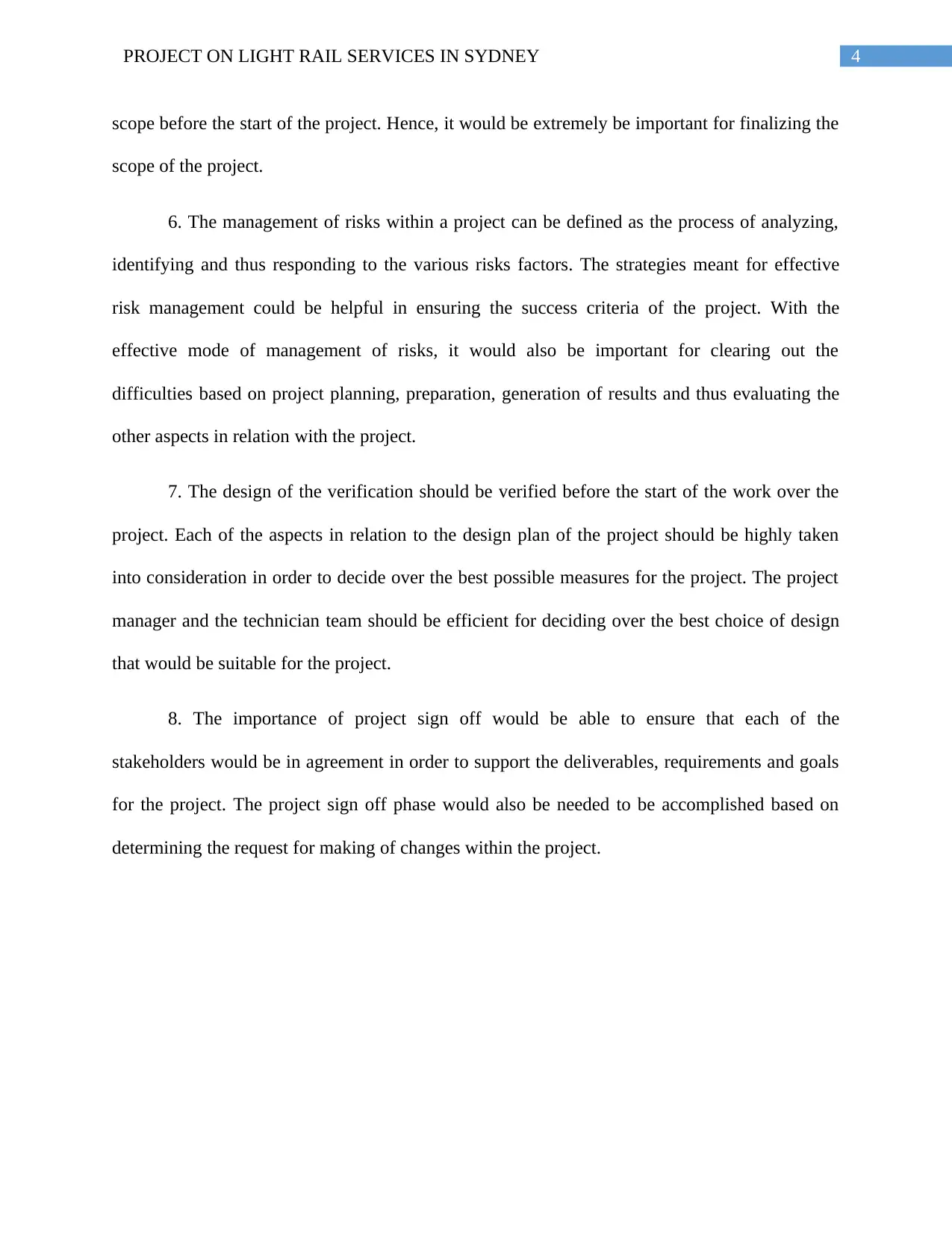
4PROJECT ON LIGHT RAIL SERVICES IN SYDNEY
scope before the start of the project. Hence, it would be extremely be important for finalizing the
scope of the project.
6. The management of risks within a project can be defined as the process of analyzing,
identifying and thus responding to the various risks factors. The strategies meant for effective
risk management could be helpful in ensuring the success criteria of the project. With the
effective mode of management of risks, it would also be important for clearing out the
difficulties based on project planning, preparation, generation of results and thus evaluating the
other aspects in relation with the project.
7. The design of the verification should be verified before the start of the work over the
project. Each of the aspects in relation to the design plan of the project should be highly taken
into consideration in order to decide over the best possible measures for the project. The project
manager and the technician team should be efficient for deciding over the best choice of design
that would be suitable for the project.
8. The importance of project sign off would be able to ensure that each of the
stakeholders would be in agreement in order to support the deliverables, requirements and goals
for the project. The project sign off phase would also be needed to be accomplished based on
determining the request for making of changes within the project.
scope before the start of the project. Hence, it would be extremely be important for finalizing the
scope of the project.
6. The management of risks within a project can be defined as the process of analyzing,
identifying and thus responding to the various risks factors. The strategies meant for effective
risk management could be helpful in ensuring the success criteria of the project. With the
effective mode of management of risks, it would also be important for clearing out the
difficulties based on project planning, preparation, generation of results and thus evaluating the
other aspects in relation with the project.
7. The design of the verification should be verified before the start of the work over the
project. Each of the aspects in relation to the design plan of the project should be highly taken
into consideration in order to decide over the best possible measures for the project. The project
manager and the technician team should be efficient for deciding over the best choice of design
that would be suitable for the project.
8. The importance of project sign off would be able to ensure that each of the
stakeholders would be in agreement in order to support the deliverables, requirements and goals
for the project. The project sign off phase would also be needed to be accomplished based on
determining the request for making of changes within the project.
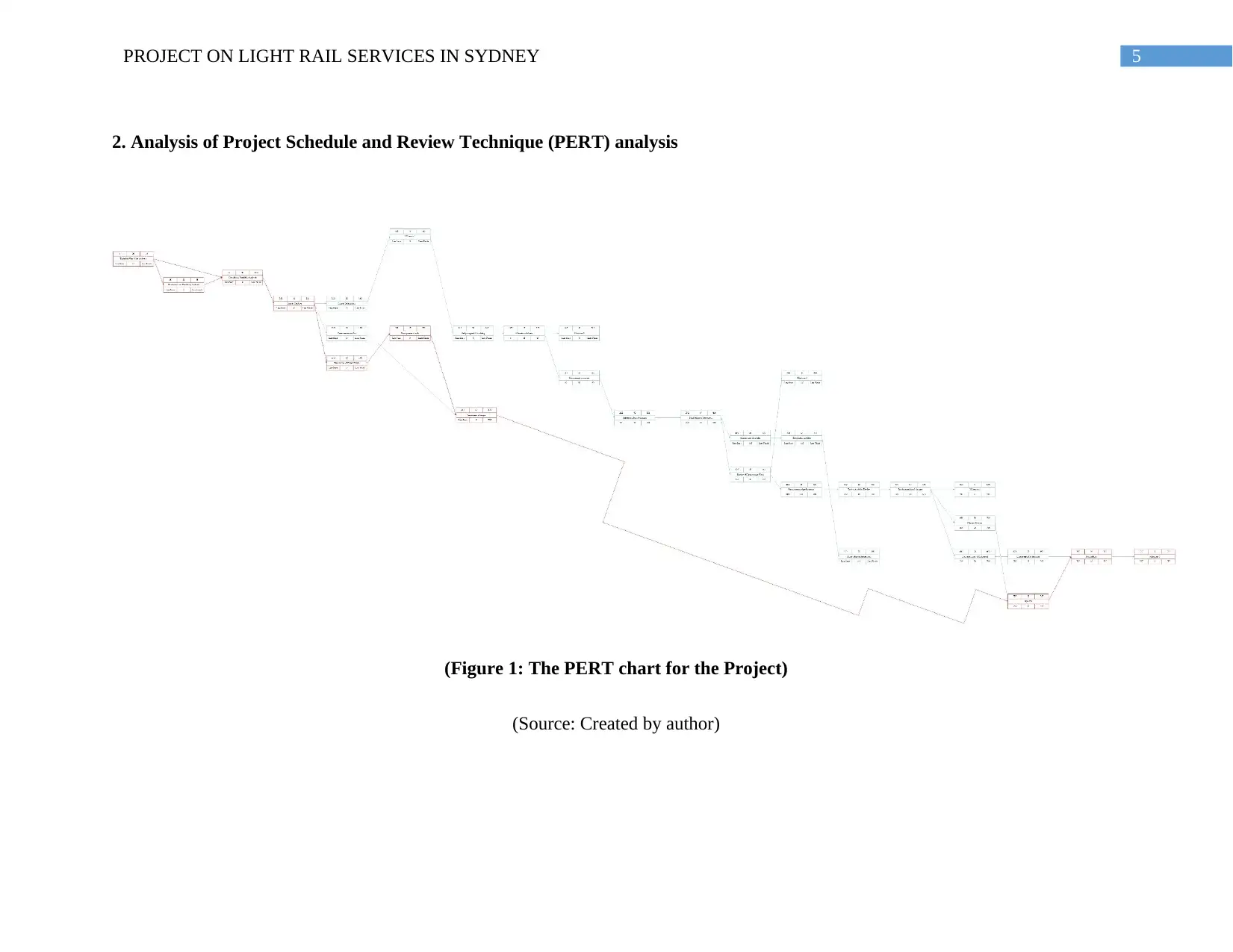
5PROJECT ON LIGHT RAIL SERVICES IN SYDNEY
2. Analysis of Project Schedule and Review Technique (PERT) analysis
(Figure 1: The PERT chart for the Project)
(Source: Created by author)
2. Analysis of Project Schedule and Review Technique (PERT) analysis
(Figure 1: The PERT chart for the Project)
(Source: Created by author)
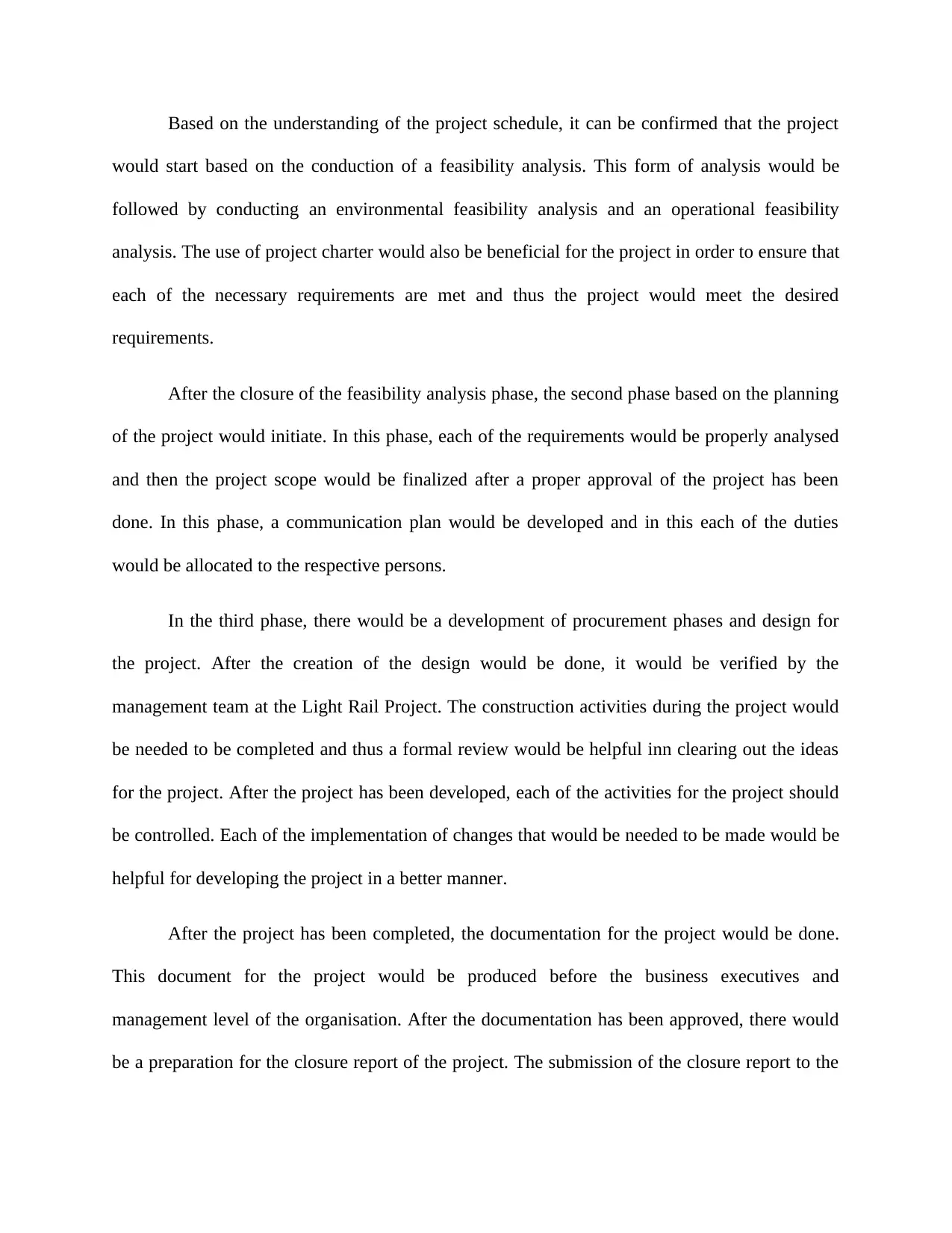
Based on the understanding of the project schedule, it can be confirmed that the project
would start based on the conduction of a feasibility analysis. This form of analysis would be
followed by conducting an environmental feasibility analysis and an operational feasibility
analysis. The use of project charter would also be beneficial for the project in order to ensure that
each of the necessary requirements are met and thus the project would meet the desired
requirements.
After the closure of the feasibility analysis phase, the second phase based on the planning
of the project would initiate. In this phase, each of the requirements would be properly analysed
and then the project scope would be finalized after a proper approval of the project has been
done. In this phase, a communication plan would be developed and in this each of the duties
would be allocated to the respective persons.
In the third phase, there would be a development of procurement phases and design for
the project. After the creation of the design would be done, it would be verified by the
management team at the Light Rail Project. The construction activities during the project would
be needed to be completed and thus a formal review would be helpful inn clearing out the ideas
for the project. After the project has been developed, each of the activities for the project should
be controlled. Each of the implementation of changes that would be needed to be made would be
helpful for developing the project in a better manner.
After the project has been completed, the documentation for the project would be done.
This document for the project would be produced before the business executives and
management level of the organisation. After the documentation has been approved, there would
be a preparation for the closure report of the project. The submission of the closure report to the
would start based on the conduction of a feasibility analysis. This form of analysis would be
followed by conducting an environmental feasibility analysis and an operational feasibility
analysis. The use of project charter would also be beneficial for the project in order to ensure that
each of the necessary requirements are met and thus the project would meet the desired
requirements.
After the closure of the feasibility analysis phase, the second phase based on the planning
of the project would initiate. In this phase, each of the requirements would be properly analysed
and then the project scope would be finalized after a proper approval of the project has been
done. In this phase, a communication plan would be developed and in this each of the duties
would be allocated to the respective persons.
In the third phase, there would be a development of procurement phases and design for
the project. After the creation of the design would be done, it would be verified by the
management team at the Light Rail Project. The construction activities during the project would
be needed to be completed and thus a formal review would be helpful inn clearing out the ideas
for the project. After the project has been developed, each of the activities for the project should
be controlled. Each of the implementation of changes that would be needed to be made would be
helpful for developing the project in a better manner.
After the project has been completed, the documentation for the project would be done.
This document for the project would be produced before the business executives and
management level of the organisation. After the documentation has been approved, there would
be a preparation for the closure report of the project. The submission of the closure report to the
Paraphrase This Document
Need a fresh take? Get an instant paraphrase of this document with our AI Paraphraser
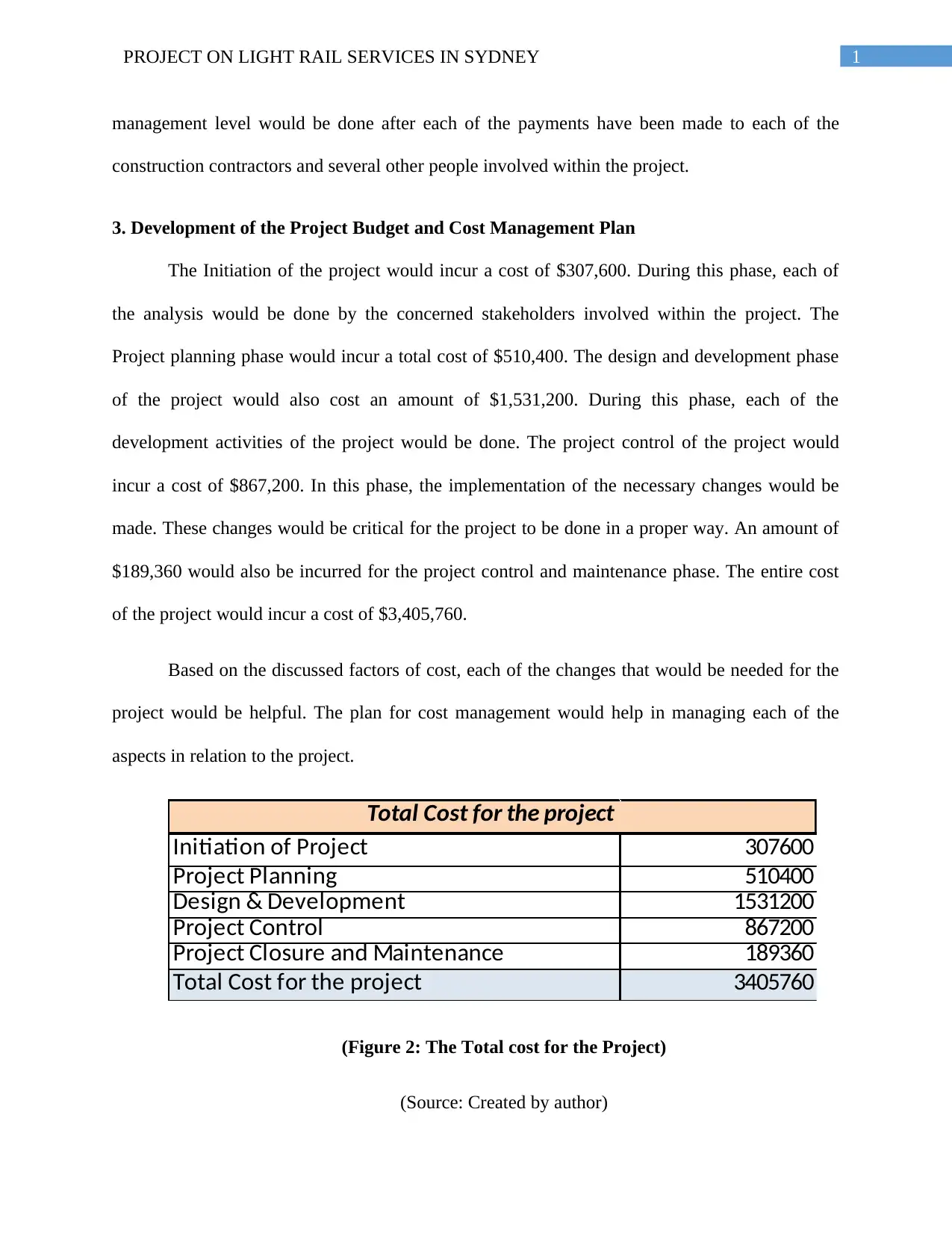
1PROJECT ON LIGHT RAIL SERVICES IN SYDNEY
management level would be done after each of the payments have been made to each of the
construction contractors and several other people involved within the project.
3. Development of the Project Budget and Cost Management Plan
The Initiation of the project would incur a cost of $307,600. During this phase, each of
the analysis would be done by the concerned stakeholders involved within the project. The
Project planning phase would incur a total cost of $510,400. The design and development phase
of the project would also cost an amount of $1,531,200. During this phase, each of the
development activities of the project would be done. The project control of the project would
incur a cost of $867,200. In this phase, the implementation of the necessary changes would be
made. These changes would be critical for the project to be done in a proper way. An amount of
$189,360 would also be incurred for the project control and maintenance phase. The entire cost
of the project would incur a cost of $3,405,760.
Based on the discussed factors of cost, each of the changes that would be needed for the
project would be helpful. The plan for cost management would help in managing each of the
aspects in relation to the project.
Initiation of Project 307600
Project Planning 510400
Design & Development 1531200
Project Control 867200
Project Closure and Maintenance 189360
Total Cost for the project 3405760
Total Cost for the project
(Figure 2: The Total cost for the Project)
(Source: Created by author)
management level would be done after each of the payments have been made to each of the
construction contractors and several other people involved within the project.
3. Development of the Project Budget and Cost Management Plan
The Initiation of the project would incur a cost of $307,600. During this phase, each of
the analysis would be done by the concerned stakeholders involved within the project. The
Project planning phase would incur a total cost of $510,400. The design and development phase
of the project would also cost an amount of $1,531,200. During this phase, each of the
development activities of the project would be done. The project control of the project would
incur a cost of $867,200. In this phase, the implementation of the necessary changes would be
made. These changes would be critical for the project to be done in a proper way. An amount of
$189,360 would also be incurred for the project control and maintenance phase. The entire cost
of the project would incur a cost of $3,405,760.
Based on the discussed factors of cost, each of the changes that would be needed for the
project would be helpful. The plan for cost management would help in managing each of the
aspects in relation to the project.
Initiation of Project 307600
Project Planning 510400
Design & Development 1531200
Project Control 867200
Project Closure and Maintenance 189360
Total Cost for the project 3405760
Total Cost for the project
(Figure 2: The Total cost for the Project)
(Source: Created by author)
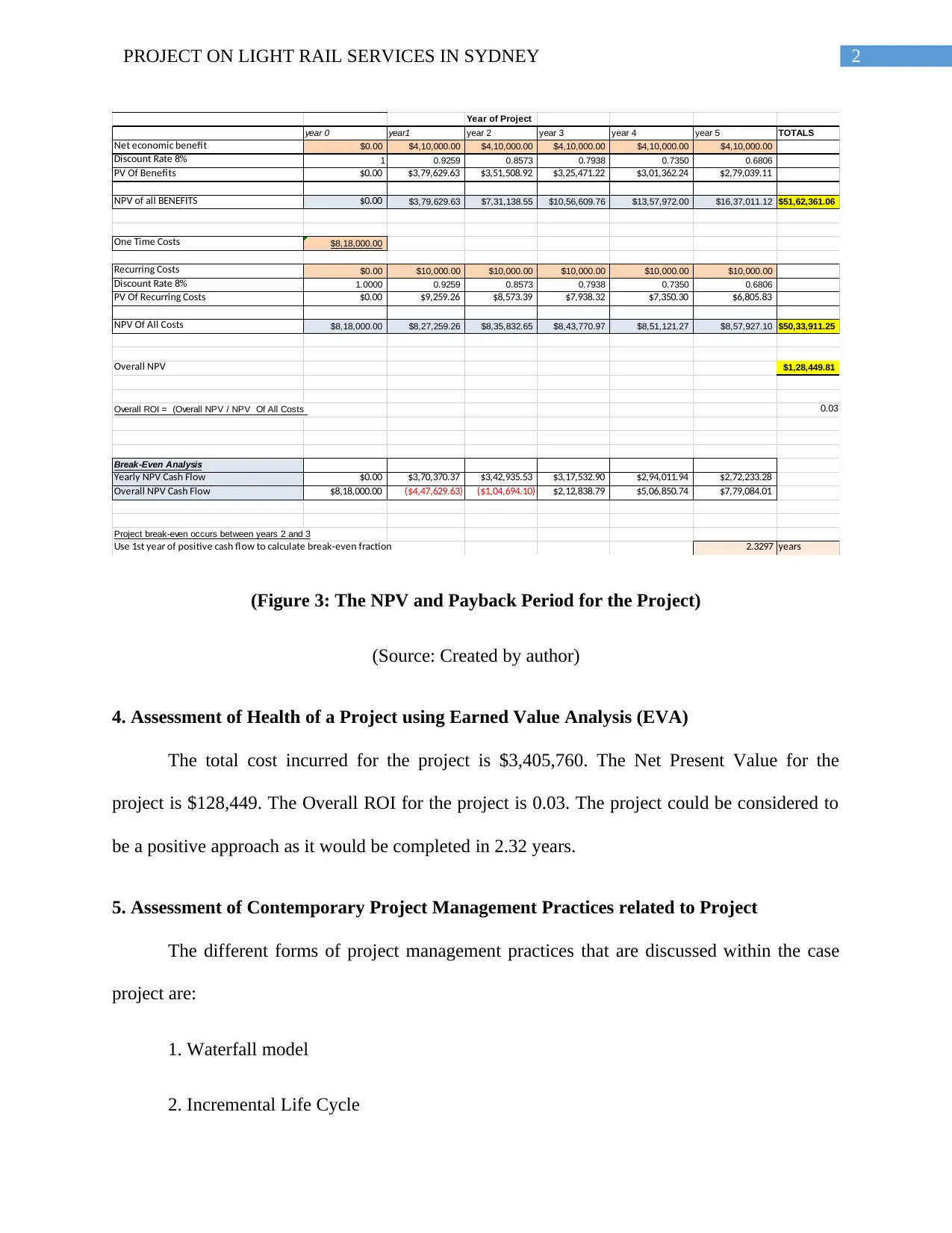
2PROJECT ON LIGHT RAIL SERVICES IN SYDNEY
Year of Project
year 0 year1 year 2 year 3 year 4 year 5 TOTALS
Net economic benefit $0.00 $4,10,000.00 $4,10,000.00 $4,10,000.00 $4,10,000.00 $4,10,000.00
Discount Rate 8% 1 0.9259 0.8573 0.7938 0.7350 0.6806
PV Of Benefits $0.00 $3,79,629.63 $3,51,508.92 $3,25,471.22 $3,01,362.24 $2,79,039.11
NPV of all BENEFITS $0.00 $3,79,629.63 $7,31,138.55 $10,56,609.76 $13,57,972.00 $16,37,011.12 $51,62,361.06
One Time Costs $8,18,000.00
Recurring Costs $0.00 $10,000.00 $10,000.00 $10,000.00 $10,000.00 $10,000.00
Discount Rate 8% 1.0000 0.9259 0.8573 0.7938 0.7350 0.6806
PV Of Recurring Costs $0.00 $9,259.26 $8,573.39 $7,938.32 $7,350.30 $6,805.83
NPV Of All Costs $8,18,000.00 $8,27,259.26 $8,35,832.65 $8,43,770.97 $8,51,121.27 $8,57,927.10 $50,33,911.25
Overall NPV $1,28,449.81
Overall ROI = (Overall NPV / NPV Of All Costs 0.03
Break-Even Analysis
Yearly NPV Cash Flow $0.00 $3,70,370.37 $3,42,935.53 $3,17,532.90 $2,94,011.94 $2,72,233.28
Overall NPV Cash Flow $8,18,000.00 ($4,47,629.63) ($1,04,694.10) $2,12,838.79 $5,06,850.74 $7,79,084.01
Project break-even occurs between years 2 and 3
Use 1st year of positive cash flow to calculate break-even fraction 2.3297 years
(Figure 3: The NPV and Payback Period for the Project)
(Source: Created by author)
4. Assessment of Health of a Project using Earned Value Analysis (EVA)
The total cost incurred for the project is $3,405,760. The Net Present Value for the
project is $128,449. The Overall ROI for the project is 0.03. The project could be considered to
be a positive approach as it would be completed in 2.32 years.
5. Assessment of Contemporary Project Management Practices related to Project
The different forms of project management practices that are discussed within the case
project are:
1. Waterfall model
2. Incremental Life Cycle
Year of Project
year 0 year1 year 2 year 3 year 4 year 5 TOTALS
Net economic benefit $0.00 $4,10,000.00 $4,10,000.00 $4,10,000.00 $4,10,000.00 $4,10,000.00
Discount Rate 8% 1 0.9259 0.8573 0.7938 0.7350 0.6806
PV Of Benefits $0.00 $3,79,629.63 $3,51,508.92 $3,25,471.22 $3,01,362.24 $2,79,039.11
NPV of all BENEFITS $0.00 $3,79,629.63 $7,31,138.55 $10,56,609.76 $13,57,972.00 $16,37,011.12 $51,62,361.06
One Time Costs $8,18,000.00
Recurring Costs $0.00 $10,000.00 $10,000.00 $10,000.00 $10,000.00 $10,000.00
Discount Rate 8% 1.0000 0.9259 0.8573 0.7938 0.7350 0.6806
PV Of Recurring Costs $0.00 $9,259.26 $8,573.39 $7,938.32 $7,350.30 $6,805.83
NPV Of All Costs $8,18,000.00 $8,27,259.26 $8,35,832.65 $8,43,770.97 $8,51,121.27 $8,57,927.10 $50,33,911.25
Overall NPV $1,28,449.81
Overall ROI = (Overall NPV / NPV Of All Costs 0.03
Break-Even Analysis
Yearly NPV Cash Flow $0.00 $3,70,370.37 $3,42,935.53 $3,17,532.90 $2,94,011.94 $2,72,233.28
Overall NPV Cash Flow $8,18,000.00 ($4,47,629.63) ($1,04,694.10) $2,12,838.79 $5,06,850.74 $7,79,084.01
Project break-even occurs between years 2 and 3
Use 1st year of positive cash flow to calculate break-even fraction 2.3297 years
(Figure 3: The NPV and Payback Period for the Project)
(Source: Created by author)
4. Assessment of Health of a Project using Earned Value Analysis (EVA)
The total cost incurred for the project is $3,405,760. The Net Present Value for the
project is $128,449. The Overall ROI for the project is 0.03. The project could be considered to
be a positive approach as it would be completed in 2.32 years.
5. Assessment of Contemporary Project Management Practices related to Project
The different forms of project management practices that are discussed within the case
project are:
1. Waterfall model
2. Incremental Life Cycle

3PROJECT ON LIGHT RAIL SERVICES IN SYDNEY
3. Spiral model
4. Iterative or Evolutionary Process
5. Agile or Extreme
However, based on the discussion over the project and comparing the different practices
of project management, it can be discussed that agile or extreme based project management
methodology is considered as the best methodology for the project. Agile is always considered as
the best approach based on the development of projects in an iterative and incremental manner. It
can be defined as a process based on collaborative effort that would be based on self-organizing.
With the help of the agile based approach in the Light Rail Project, the teams would be able to
function among them in a cross-functional manner. Although the agile based method was
primarily based for the methods of software development, but in the recent time there have been
an urgent need for the delivery of projects with the help of the agile based method.
Based on the methodology of project management, the Light Rail Project would be
broken down into several phases. The use of agile mode of project management within the Light
Rail Project of Sydney would help in the completion of tasks by breaking them in several work
sessions. The schedule defined under the project schedule would help in understanding about the
use of each of the phases within the project. Each of the project phases can be defined as sprints.
These sprints would generally be considered as short that would be defined under weeks or days.
This mode of developing of the project would help in the review over each of the phases. After a
proper approval over each of the phases of the project.
The process that should be followed within the development works over the Light Rail
Project in Sydney would incur the use of agile based techniques. The agile based team that
3. Spiral model
4. Iterative or Evolutionary Process
5. Agile or Extreme
However, based on the discussion over the project and comparing the different practices
of project management, it can be discussed that agile or extreme based project management
methodology is considered as the best methodology for the project. Agile is always considered as
the best approach based on the development of projects in an iterative and incremental manner. It
can be defined as a process based on collaborative effort that would be based on self-organizing.
With the help of the agile based approach in the Light Rail Project, the teams would be able to
function among them in a cross-functional manner. Although the agile based method was
primarily based for the methods of software development, but in the recent time there have been
an urgent need for the delivery of projects with the help of the agile based method.
Based on the methodology of project management, the Light Rail Project would be
broken down into several phases. The use of agile mode of project management within the Light
Rail Project of Sydney would help in the completion of tasks by breaking them in several work
sessions. The schedule defined under the project schedule would help in understanding about the
use of each of the phases within the project. Each of the project phases can be defined as sprints.
These sprints would generally be considered as short that would be defined under weeks or days.
This mode of developing of the project would help in the review over each of the phases. After a
proper approval over each of the phases of the project.
The process that should be followed within the development works over the Light Rail
Project in Sydney would incur the use of agile based techniques. The agile based team that
Secure Best Marks with AI Grader
Need help grading? Try our AI Grader for instant feedback on your assignments.
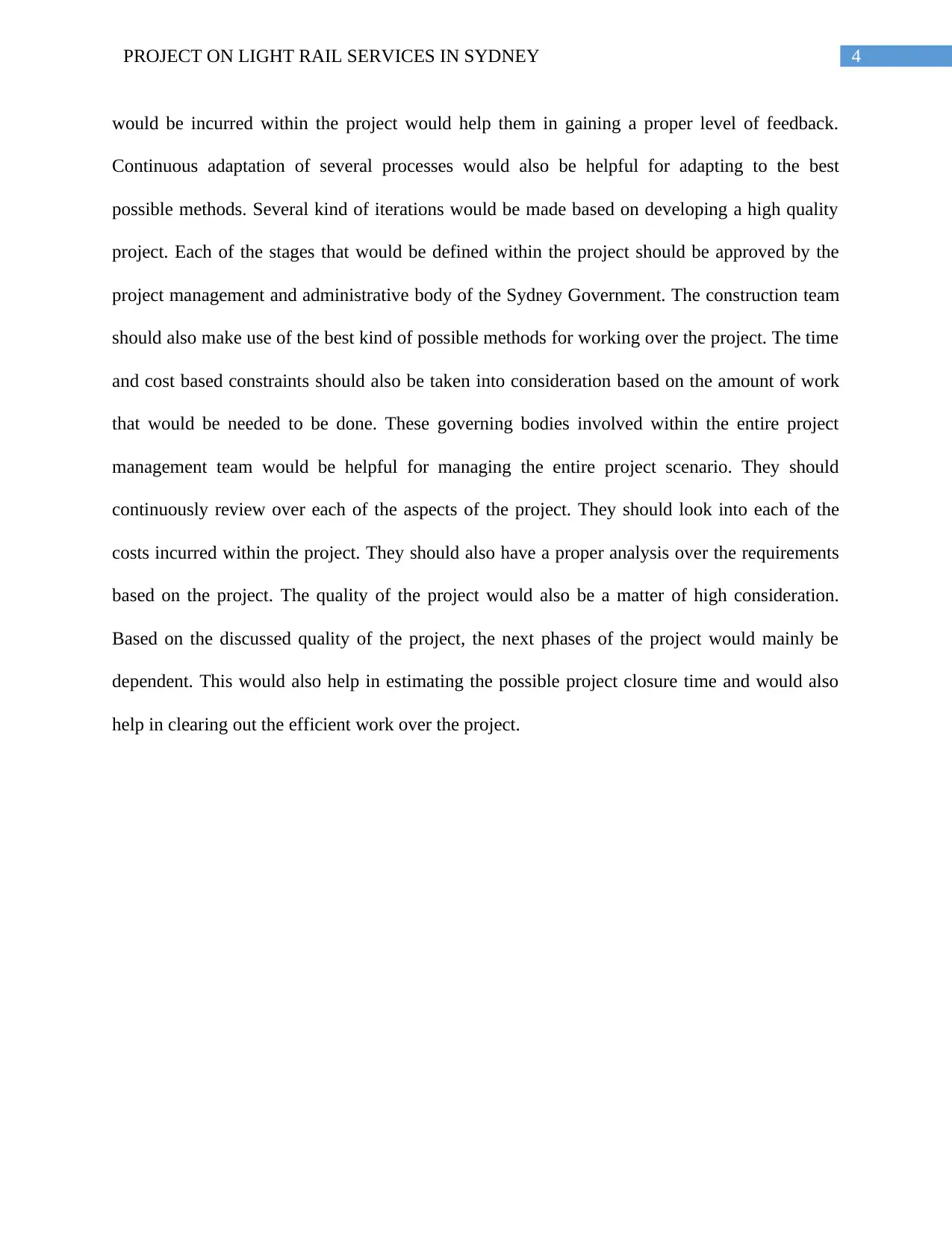
4PROJECT ON LIGHT RAIL SERVICES IN SYDNEY
would be incurred within the project would help them in gaining a proper level of feedback.
Continuous adaptation of several processes would also be helpful for adapting to the best
possible methods. Several kind of iterations would be made based on developing a high quality
project. Each of the stages that would be defined within the project should be approved by the
project management and administrative body of the Sydney Government. The construction team
should also make use of the best kind of possible methods for working over the project. The time
and cost based constraints should also be taken into consideration based on the amount of work
that would be needed to be done. These governing bodies involved within the entire project
management team would be helpful for managing the entire project scenario. They should
continuously review over each of the aspects of the project. They should look into each of the
costs incurred within the project. They should also have a proper analysis over the requirements
based on the project. The quality of the project would also be a matter of high consideration.
Based on the discussed quality of the project, the next phases of the project would mainly be
dependent. This would also help in estimating the possible project closure time and would also
help in clearing out the efficient work over the project.
would be incurred within the project would help them in gaining a proper level of feedback.
Continuous adaptation of several processes would also be helpful for adapting to the best
possible methods. Several kind of iterations would be made based on developing a high quality
project. Each of the stages that would be defined within the project should be approved by the
project management and administrative body of the Sydney Government. The construction team
should also make use of the best kind of possible methods for working over the project. The time
and cost based constraints should also be taken into consideration based on the amount of work
that would be needed to be done. These governing bodies involved within the entire project
management team would be helpful for managing the entire project scenario. They should
continuously review over each of the aspects of the project. They should look into each of the
costs incurred within the project. They should also have a proper analysis over the requirements
based on the project. The quality of the project would also be a matter of high consideration.
Based on the discussed quality of the project, the next phases of the project would mainly be
dependent. This would also help in estimating the possible project closure time and would also
help in clearing out the efficient work over the project.
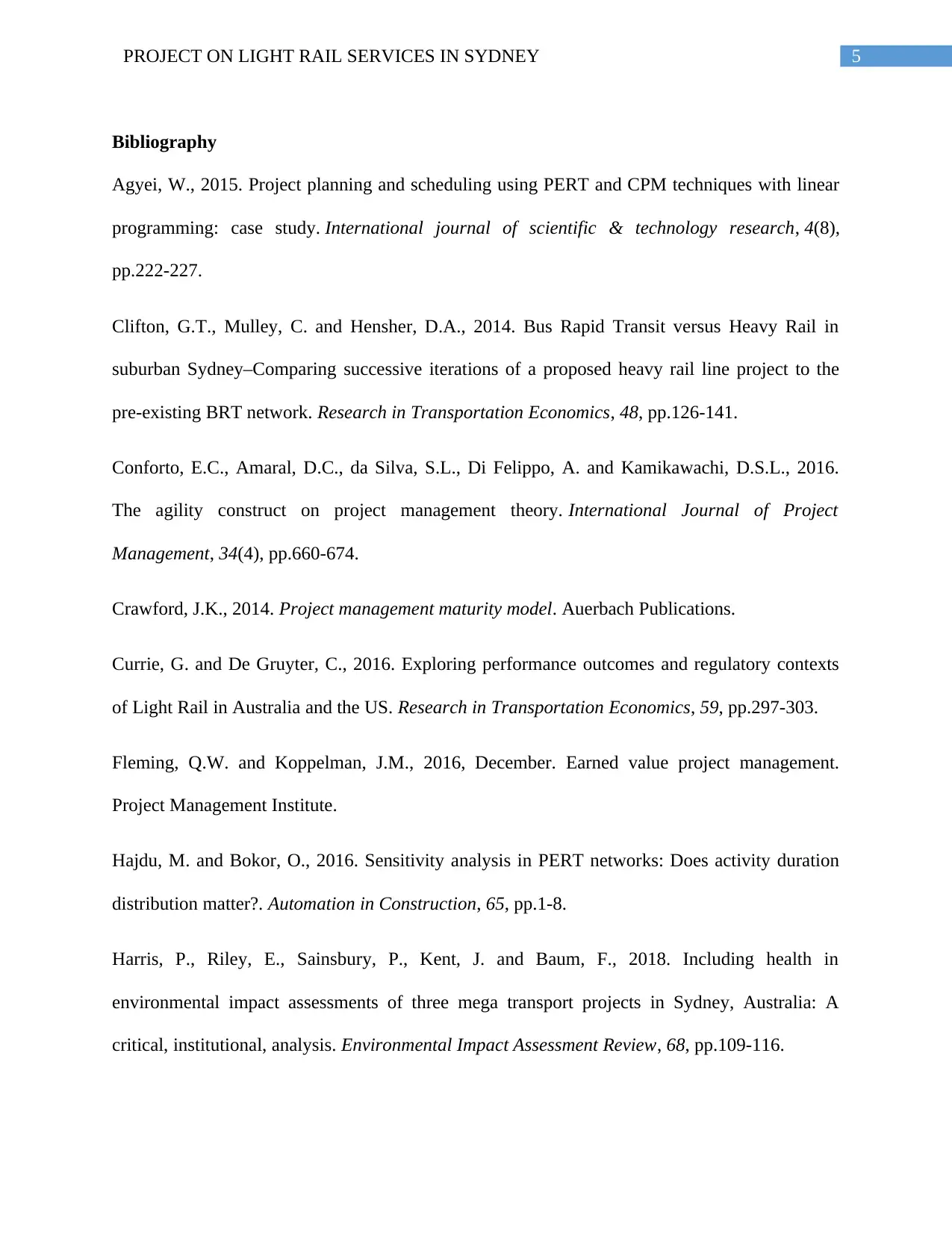
5PROJECT ON LIGHT RAIL SERVICES IN SYDNEY
Bibliography
Agyei, W., 2015. Project planning and scheduling using PERT and CPM techniques with linear
programming: case study. International journal of scientific & technology research, 4(8),
pp.222-227.
Clifton, G.T., Mulley, C. and Hensher, D.A., 2014. Bus Rapid Transit versus Heavy Rail in
suburban Sydney–Comparing successive iterations of a proposed heavy rail line project to the
pre-existing BRT network. Research in Transportation Economics, 48, pp.126-141.
Conforto, E.C., Amaral, D.C., da Silva, S.L., Di Felippo, A. and Kamikawachi, D.S.L., 2016.
The agility construct on project management theory. International Journal of Project
Management, 34(4), pp.660-674.
Crawford, J.K., 2014. Project management maturity model. Auerbach Publications.
Currie, G. and De Gruyter, C., 2016. Exploring performance outcomes and regulatory contexts
of Light Rail in Australia and the US. Research in Transportation Economics, 59, pp.297-303.
Fleming, Q.W. and Koppelman, J.M., 2016, December. Earned value project management.
Project Management Institute.
Hajdu, M. and Bokor, O., 2016. Sensitivity analysis in PERT networks: Does activity duration
distribution matter?. Automation in Construction, 65, pp.1-8.
Harris, P., Riley, E., Sainsbury, P., Kent, J. and Baum, F., 2018. Including health in
environmental impact assessments of three mega transport projects in Sydney, Australia: A
critical, institutional, analysis. Environmental Impact Assessment Review, 68, pp.109-116.
Bibliography
Agyei, W., 2015. Project planning and scheduling using PERT and CPM techniques with linear
programming: case study. International journal of scientific & technology research, 4(8),
pp.222-227.
Clifton, G.T., Mulley, C. and Hensher, D.A., 2014. Bus Rapid Transit versus Heavy Rail in
suburban Sydney–Comparing successive iterations of a proposed heavy rail line project to the
pre-existing BRT network. Research in Transportation Economics, 48, pp.126-141.
Conforto, E.C., Amaral, D.C., da Silva, S.L., Di Felippo, A. and Kamikawachi, D.S.L., 2016.
The agility construct on project management theory. International Journal of Project
Management, 34(4), pp.660-674.
Crawford, J.K., 2014. Project management maturity model. Auerbach Publications.
Currie, G. and De Gruyter, C., 2016. Exploring performance outcomes and regulatory contexts
of Light Rail in Australia and the US. Research in Transportation Economics, 59, pp.297-303.
Fleming, Q.W. and Koppelman, J.M., 2016, December. Earned value project management.
Project Management Institute.
Hajdu, M. and Bokor, O., 2016. Sensitivity analysis in PERT networks: Does activity duration
distribution matter?. Automation in Construction, 65, pp.1-8.
Harris, P., Riley, E., Sainsbury, P., Kent, J. and Baum, F., 2018. Including health in
environmental impact assessments of three mega transport projects in Sydney, Australia: A
critical, institutional, analysis. Environmental Impact Assessment Review, 68, pp.109-116.
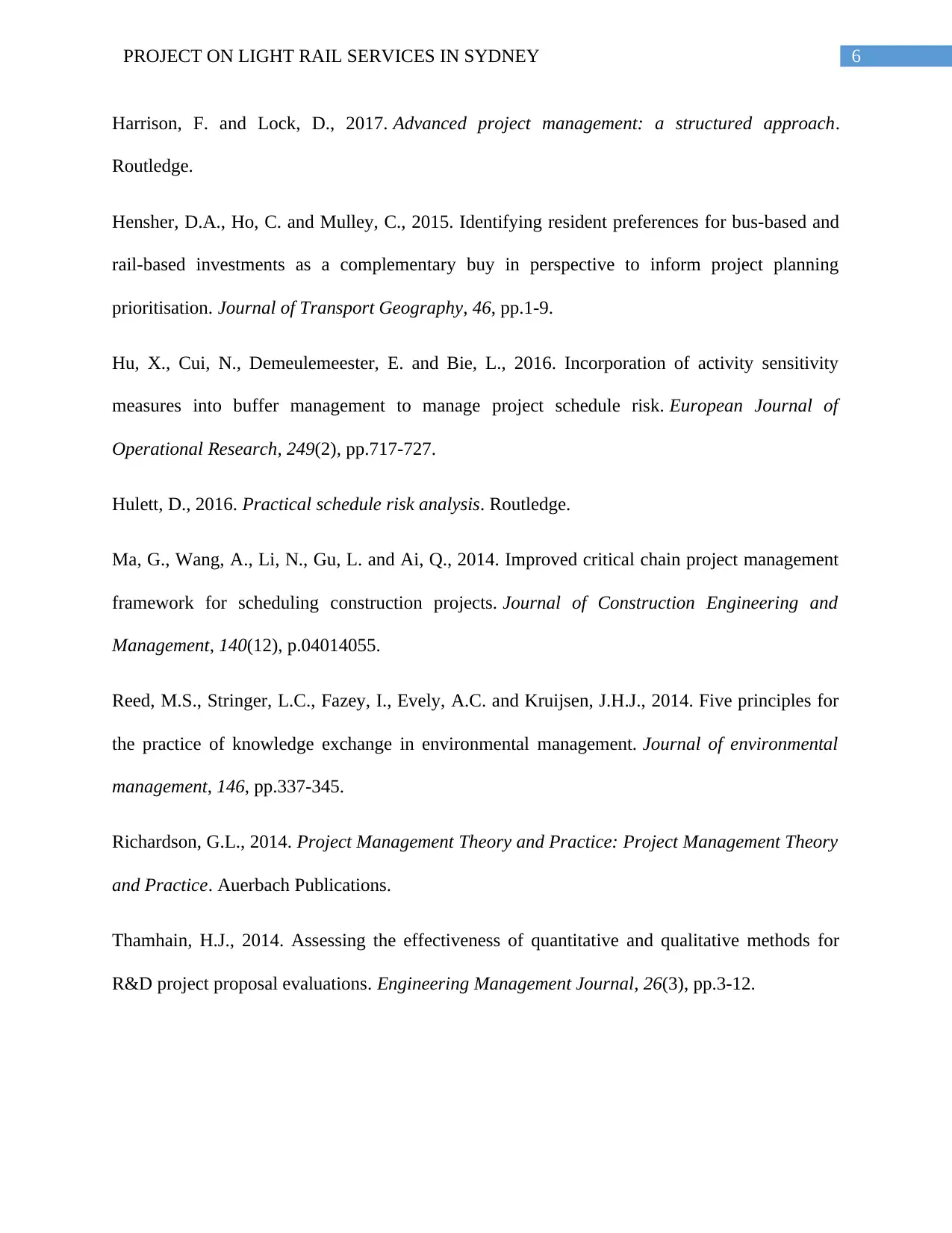
6PROJECT ON LIGHT RAIL SERVICES IN SYDNEY
Harrison, F. and Lock, D., 2017. Advanced project management: a structured approach.
Routledge.
Hensher, D.A., Ho, C. and Mulley, C., 2015. Identifying resident preferences for bus-based and
rail-based investments as a complementary buy in perspective to inform project planning
prioritisation. Journal of Transport Geography, 46, pp.1-9.
Hu, X., Cui, N., Demeulemeester, E. and Bie, L., 2016. Incorporation of activity sensitivity
measures into buffer management to manage project schedule risk. European Journal of
Operational Research, 249(2), pp.717-727.
Hulett, D., 2016. Practical schedule risk analysis. Routledge.
Ma, G., Wang, A., Li, N., Gu, L. and Ai, Q., 2014. Improved critical chain project management
framework for scheduling construction projects. Journal of Construction Engineering and
Management, 140(12), p.04014055.
Reed, M.S., Stringer, L.C., Fazey, I., Evely, A.C. and Kruijsen, J.H.J., 2014. Five principles for
the practice of knowledge exchange in environmental management. Journal of environmental
management, 146, pp.337-345.
Richardson, G.L., 2014. Project Management Theory and Practice: Project Management Theory
and Practice. Auerbach Publications.
Thamhain, H.J., 2014. Assessing the effectiveness of quantitative and qualitative methods for
R&D project proposal evaluations. Engineering Management Journal, 26(3), pp.3-12.
Harrison, F. and Lock, D., 2017. Advanced project management: a structured approach.
Routledge.
Hensher, D.A., Ho, C. and Mulley, C., 2015. Identifying resident preferences for bus-based and
rail-based investments as a complementary buy in perspective to inform project planning
prioritisation. Journal of Transport Geography, 46, pp.1-9.
Hu, X., Cui, N., Demeulemeester, E. and Bie, L., 2016. Incorporation of activity sensitivity
measures into buffer management to manage project schedule risk. European Journal of
Operational Research, 249(2), pp.717-727.
Hulett, D., 2016. Practical schedule risk analysis. Routledge.
Ma, G., Wang, A., Li, N., Gu, L. and Ai, Q., 2014. Improved critical chain project management
framework for scheduling construction projects. Journal of Construction Engineering and
Management, 140(12), p.04014055.
Reed, M.S., Stringer, L.C., Fazey, I., Evely, A.C. and Kruijsen, J.H.J., 2014. Five principles for
the practice of knowledge exchange in environmental management. Journal of environmental
management, 146, pp.337-345.
Richardson, G.L., 2014. Project Management Theory and Practice: Project Management Theory
and Practice. Auerbach Publications.
Thamhain, H.J., 2014. Assessing the effectiveness of quantitative and qualitative methods for
R&D project proposal evaluations. Engineering Management Journal, 26(3), pp.3-12.
1 out of 13
Related Documents
Your All-in-One AI-Powered Toolkit for Academic Success.
+13062052269
info@desklib.com
Available 24*7 on WhatsApp / Email
![[object Object]](/_next/static/media/star-bottom.7253800d.svg)
Unlock your academic potential
© 2024 | Zucol Services PVT LTD | All rights reserved.





